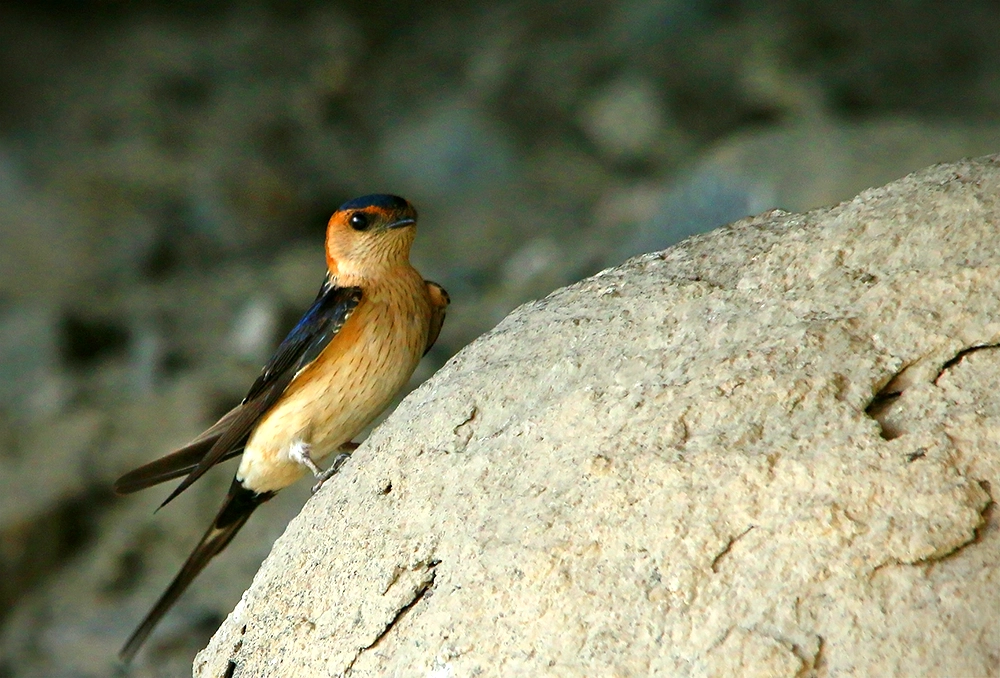
1. RED-RUMPED SWALLOW (Cecropis daurica)
- Between March and October
A small, nimble passerine bird, the Red-rumped Swallow has a glossy, blue-black upper body and a pale, buff-orange underbody. Its most distinguishing feature is the reddish-orange rump, which contrasts with the rest of its plumage. It has a forked tail, a pale throat, and a dark eye mask. Red-rumped Swallows prefer open habitats with access to water, such as grasslands, farmlands, marshes, and river valleys, often near cliffs or other natural or man-made structures suitable for nesting. Their aerial acrobatics and graceful appearance make them an especially attractive sight for nature enthusiasts. In the Algarve, this species is more abundant in the hilly countryside. However, it also occurs along the coast in places like Carrapateira, Lagos (Ponta da Piedade), Dunas Douradas, Quinta do Lago, Vilamoura and Castro Marim.
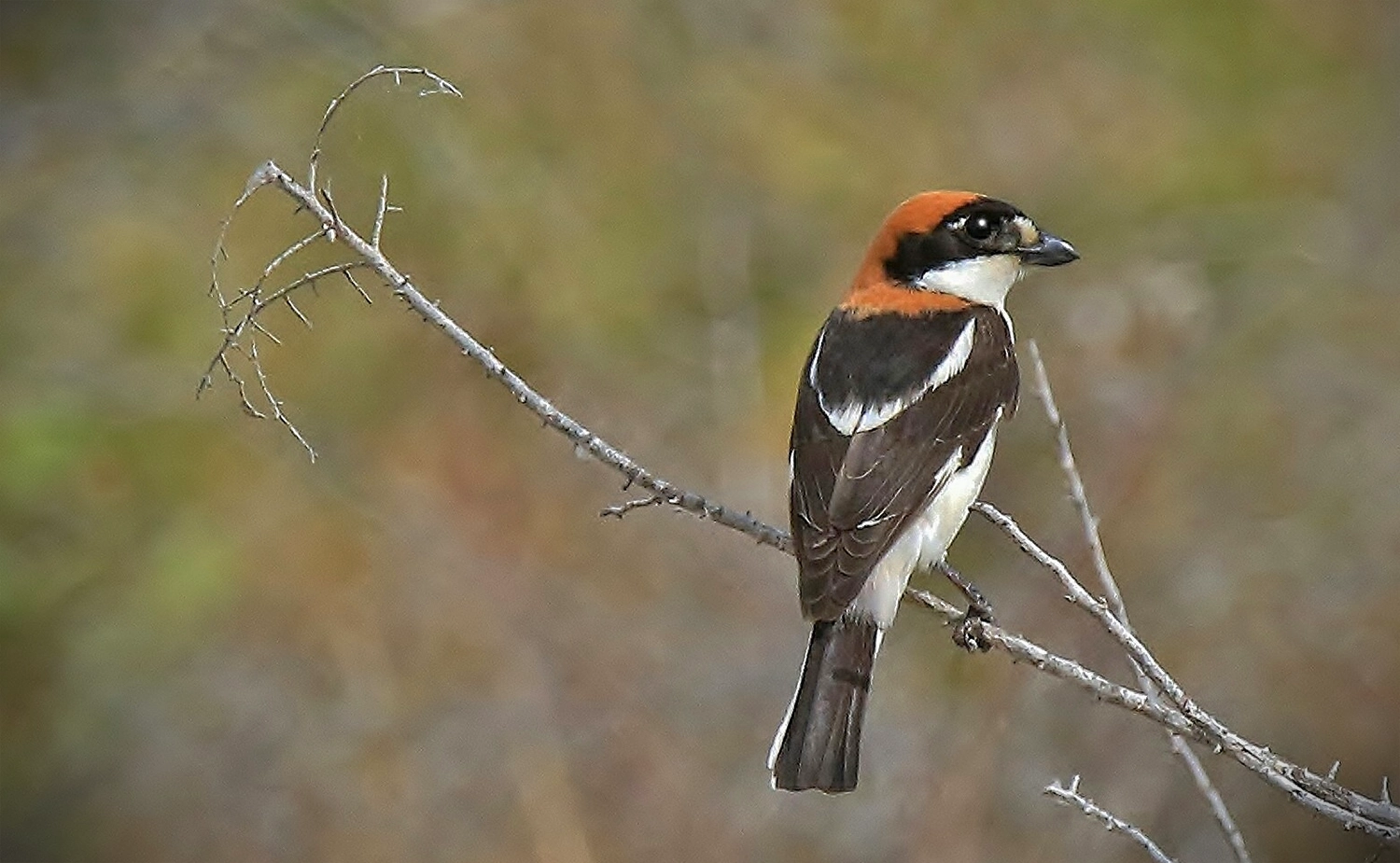
2. WOODCHAT SHRIKE (Lanius senator)
- Between March and September
Males have a striking plumage, featuring a chestnut brown crown and nape, a black mask around the eyes, a gray back, and a white underbody. Females have a duller coloration, with a brownish back and a paler, less distinct facial mask. Woodchat Shrikes prefer habitats with a mixture of open areas and scattered trees or shrubs, such as woodland edges, orchards, and farmlands. These birds have a diverse diet, feeding on a variety of insects (mainly), but they also capture small mammals and reptiles. They often employ a “sit-and-wait” hunting strategy, perching on a high vantage point and scanning the surroundings for prey before swooping down to catch it. In the Algarve, this beautiful shrike can be found both in the countryside and along the coast (namely in places such as Rocha da Pena, Fonte Benémola, Lagos and Alvor, among many others).
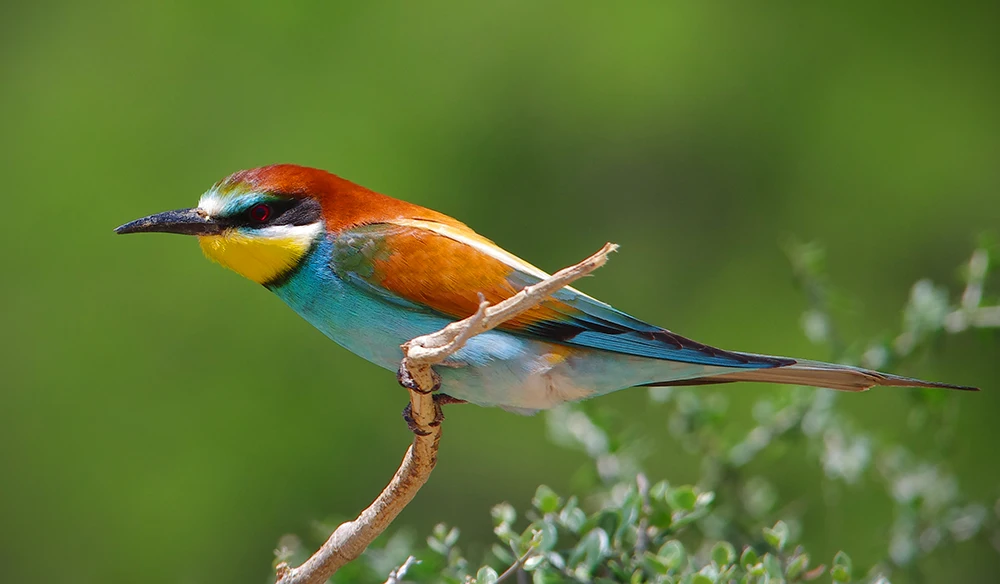
3. BEE-EATER (Merops apiaster)
- Between April and September
Among the most colorful birds of Algarve, this is a medium-sized species with slender body, a slightly curved beak, and long, pointed wings. Their stunning plumage is a vibrant mix of colors, including a turquoise-blue belly, a chestnut-colored crown, a black eye stripe, and a bright yellow throat. Bee-eaters prefer habitats with open spaces, such as grasslands, savannas, and farmlands, often near water bodies like rivers or lakes. As their name suggests, Bee-eaters primarily feed on bees and wasps, which they catch skillfully in mid-air. Bee-eaters are social birds and are often seen in small flocks. They nest colonially, digging tunnels into sandy banks or cliffs, which can extend up to several feet in length. These agile birds are known for their acrobatic flight, often swooping and diving to catch insects, making them a delight to watch. Bee-eaters are a common sight in the Algarve, particularly along the coast in locations such as Castro Marim, Alvor, and Ria Formosa (Pontal and Ludo).
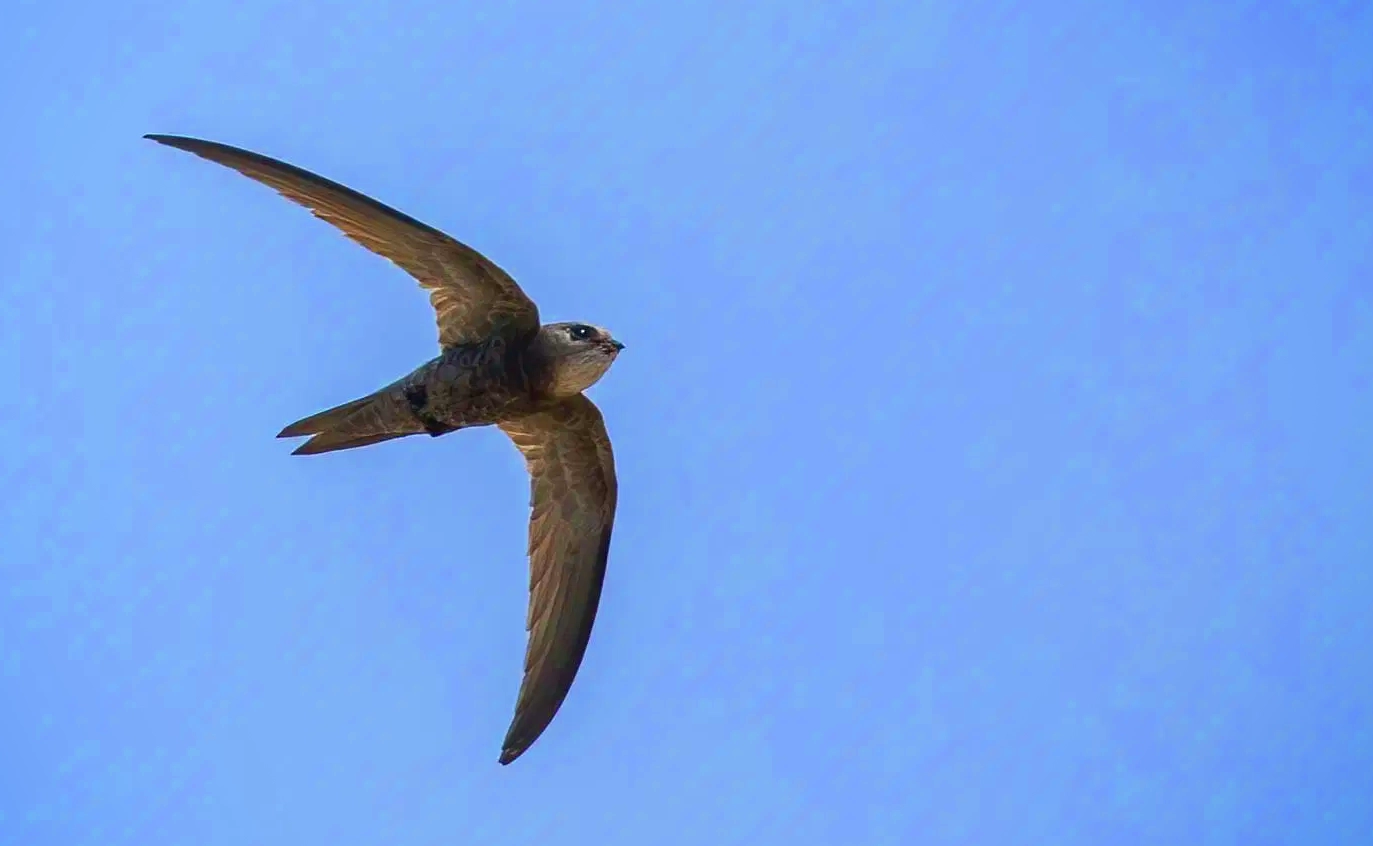
4. PALLID SWIFT (Apus pallidus)
- Between March and October
This small swift’s overall plumage is a pale brownish-grey color, with a white throat patch, a short, forked tail, and long, slender wings that contribute to its aerodynamic flight. Pallid Swifts prefer habitats near coastal cliffs, mountain ranges, and open landscapes with scattered trees and buildings for nesting. They can be found across the Mediterranean region, southern Europe, northern Africa, and the Middle East, with some populations migrating to sub-Saharan Africa during the non-breeding season. These birds have a highly aerial lifestyle, spending most of their time in the air, and are adept at catching insects on the wing. In the Algarve, the Pallid Swift is easily observable in places such as Cape St. Vincent, Carrapateira, Ponta da Piedade, Alvor, and Castro Marim.
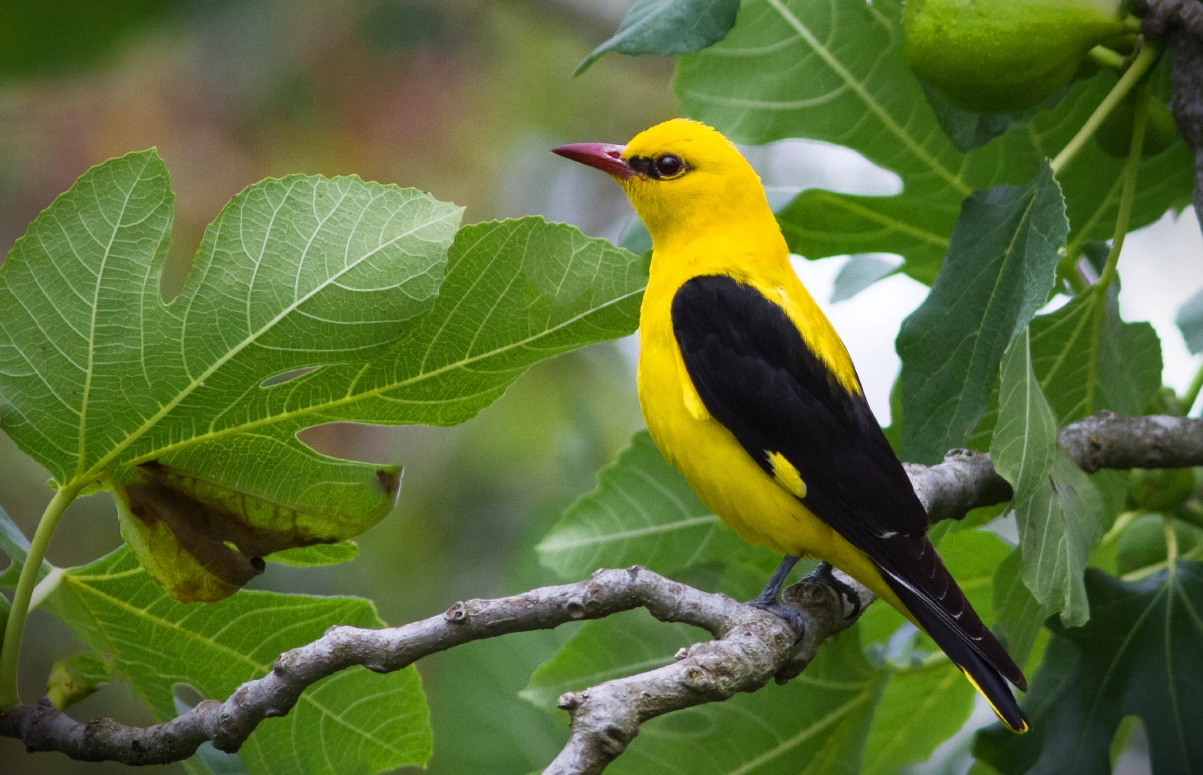
5. GOLDEN ORIOLE (Oriolus oriolus)
- Between April and September
This is a medium-sized, brightly colored bird. Males exhibit striking yellow plumage with black wings and a black tail, while females have a more subdued greenish-yellow coloration with dark wings and tail. Golden Orioles prefer habitats with a mix of deciduous trees and open spaces, such as woodlands, orchards, parks, and riverine forests. These birds primarily feed on insects like beetles, caterpillars, and ants, as well as fruits and berries. They forage at various levels in the trees, moving nimbly among the branches in search of food. During the breeding season, Golden Orioles are known to be shy and elusive, often remaining hidden among the foliage. In the Algarve, this bird is easier to find in the countryside, particularly around Alcoutim and in Serra do Caldeirão. It also occurs in Alvor.
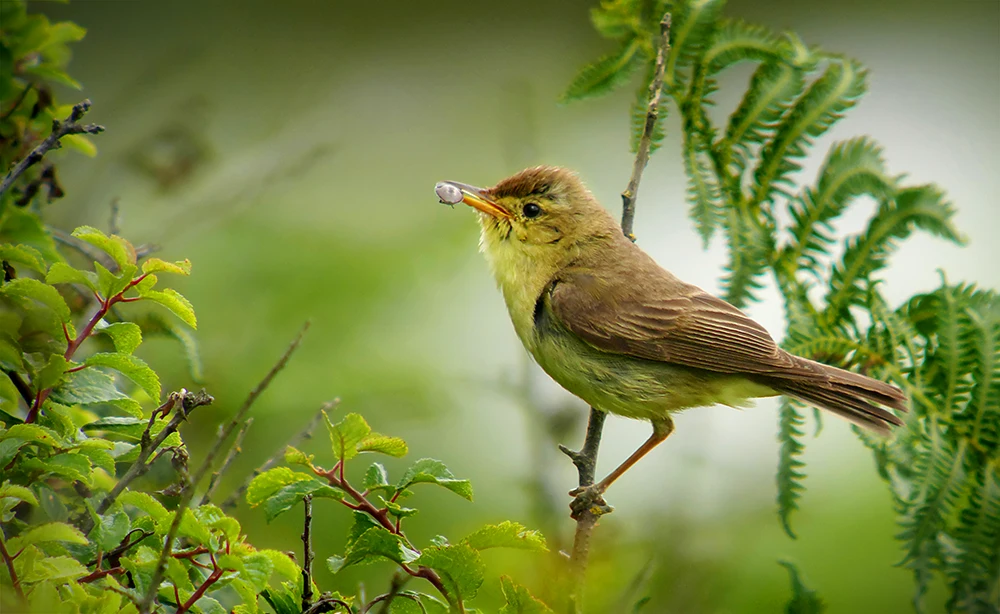
6. MELODIOUS WARBLER (Hippolais polyglotta)
- Between April and September
The plumage of the Melodious Warbler is predominantly olive-green on the upperparts and pale yellowish-white on the underparts. This bird has a short, rounded tail, and relatively long legs. The species prefers habitats with a mix of shrubs, bushes, and trees, such as woodland edges, hedgerows, and scrublands. The Melodious Warbler is primarily insectivorous, feeding on a variety of insects such as flies, beetles, and caterpillars. This species is abundant in the algarvian countryside in places such as Fonte Benémola and Rocha da Pena, but is also present around the Alvor estuary.
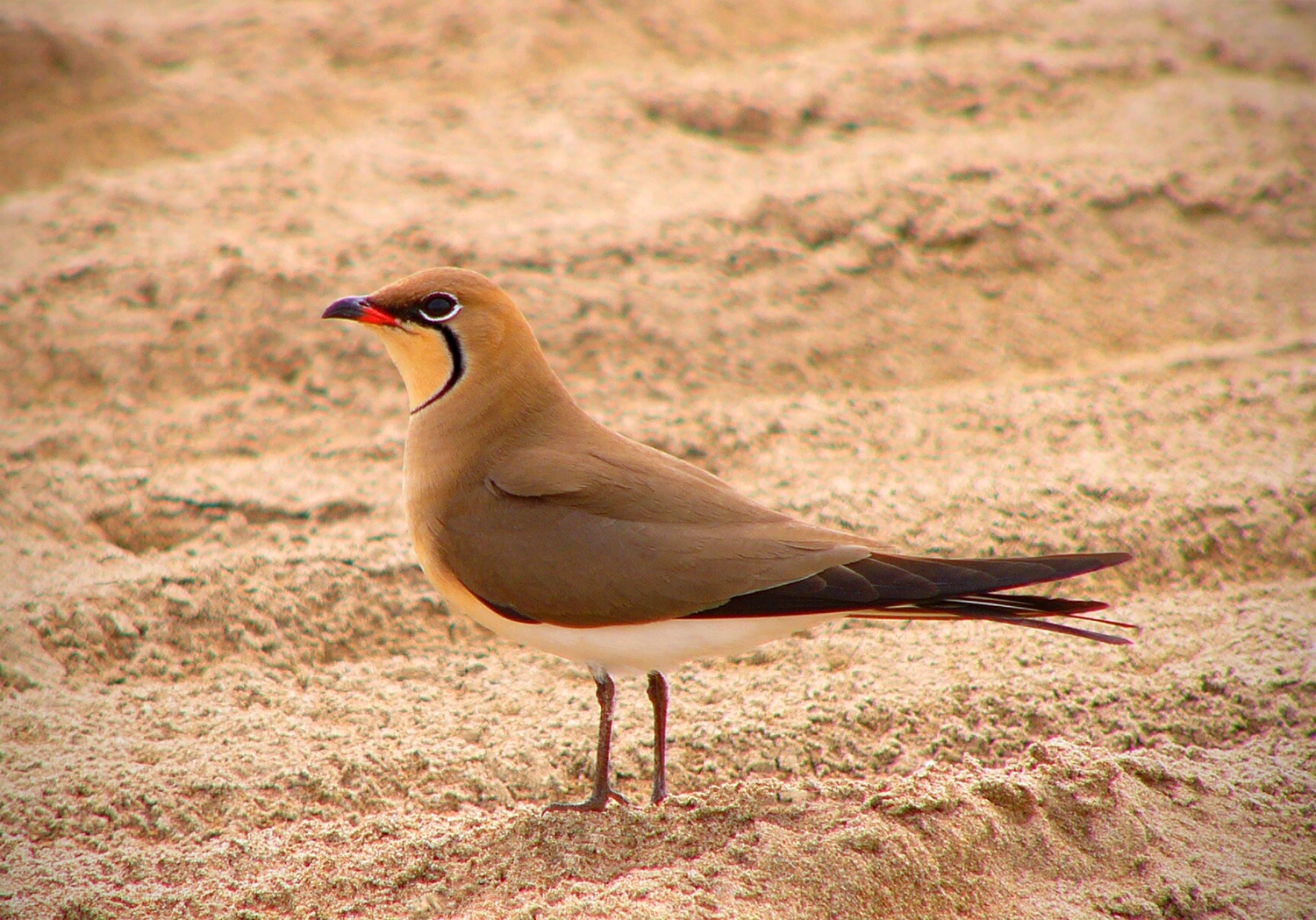
7. COLLARED PRATINCOLE (Glareola pratincola)
- Between March and September
This bird has a unique appearance, combining features of waders and terns. The species has a slender body, long pointed wings, and a short, slightly curved bill. Its plumage is mainly brownish-gray on the upperparts and pale on the underparts, with a distinctive black collar on the neck and a forked tail. The Collared Pratincole prefers open habitats such as grasslands, wetlands, marshes, and riverbanks, often with sandy or gravelly substrates. The species feeds on insects, including beetles, grasshoppers, and flying ants, which it catches on the ground or in the air, using its agile flight and sharp beak. The Collared Pratincole is known for its distinctive hunting behavior, which combines terrestrial foraging with aerial pursuits, resembling the feeding styles of both waders and terns. It occurs in Castro Marim during the breeding season, and as a passage migrant in Alvor.
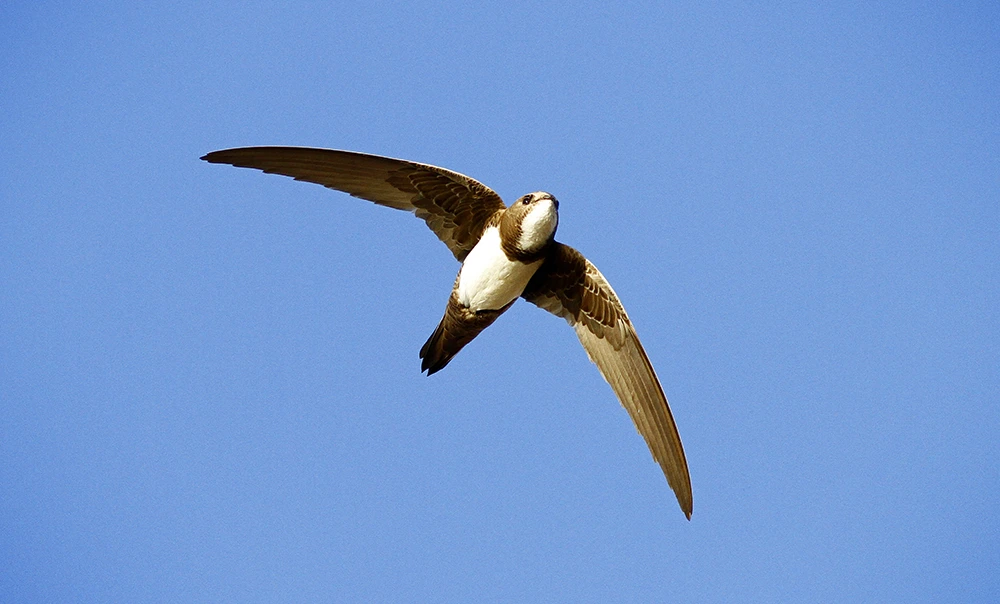
8. ALPINE SWIFT (Tachymarptis melba)
- Between March and September
A large, fast-flying swift, its plumage is characterized by a dark brownish-black upper body, contrasting with a white throat and belly. It has a short, slightly forked tail and long, narrow, swept-back wings that enable its swift and agile flight. Alpine Swifts prefer habitats near cliffs, gorges, and mountains. These birds are highly aerial and feed almost exclusively on flying insects. They are known for their remarkable ability to stay airborne for extended periods, even sleeping and mating in flight. In the Algarve, this remarkable species can be found mainly along the rocky shores to the west of Albufeira, as well as along the Vicentine Coast Natural Park (particularly in the vicinity of Cape St. Vincent).
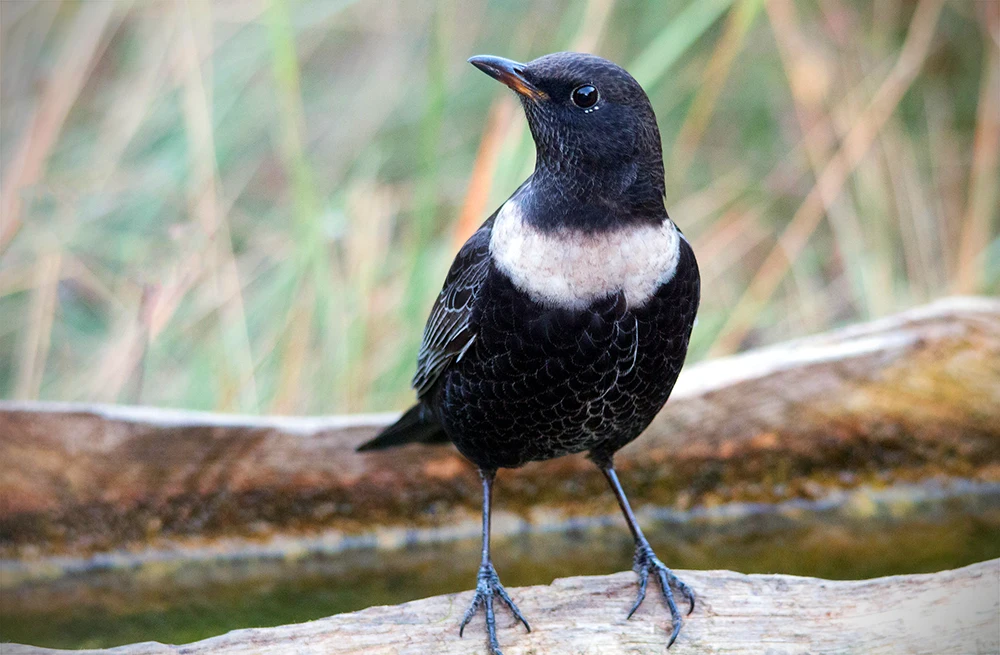
9. RING OUZEL (Turdus torquatus)
- Winter
The Ring Ouzel is a medium-sized songbird belonging to the thrush family. Males exhibit a dark, slate-grey plumage with a distinctive white crescent-shaped band across the breast, while females are generally browner with a less prominent breast band. This bird prefers upland habitats with a mix of grassland, heath, and moorland, usually at elevations between 300 and 1.000 meters (1.000-3.300 feet) above sea level. They can also be found in steep-sided valleys with scattered trees, bushes, and rocky outcrops. This species is primarily insectivorous during the breeding season, consuming invertebrates like beetles, ants, and caterpillars. However, they also feed on fruits and berries, particularly during migration and wintering periods. In winter, this species can be seen in Cape St. Vincent, Monchique and Rocha da Pena.
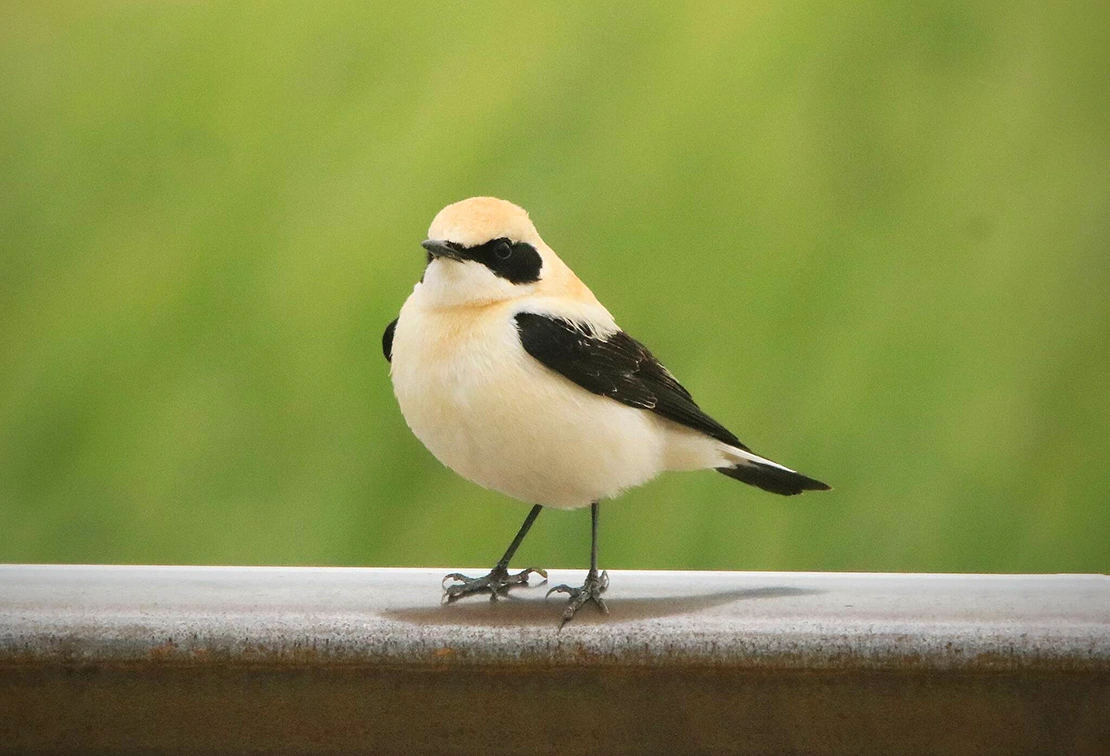
10. WESTERN BLACK-EARED WHEATEAR (Oenanthe hispanica)
- Between March and September
Males have a predominantly pale sandy-gray upper body, a black eye mask, and a black patch on their ear coverts, which gives them the “black-eared” name. Their underparts are white or pale buff, with black wings and tail. Females have a more muted coloration, with a gray-brown upper body, buff underparts, and a less distinct facial pattern. This species prefers open, dry habitats such as grasslands, heathlands, and scrublands, often with scattered trees, rocks, or slopes. These birds mainly feed on insects, such as beetles, ants, and grasshoppers, which they catch on the ground or in low vegetation. They are also known to consume seeds and fruits occasionally. In the Algarve, this bird is more abundant in the northeast, particularly in Alcoutim and Castro Marim, as well as in the countryside to the north of Tavira.
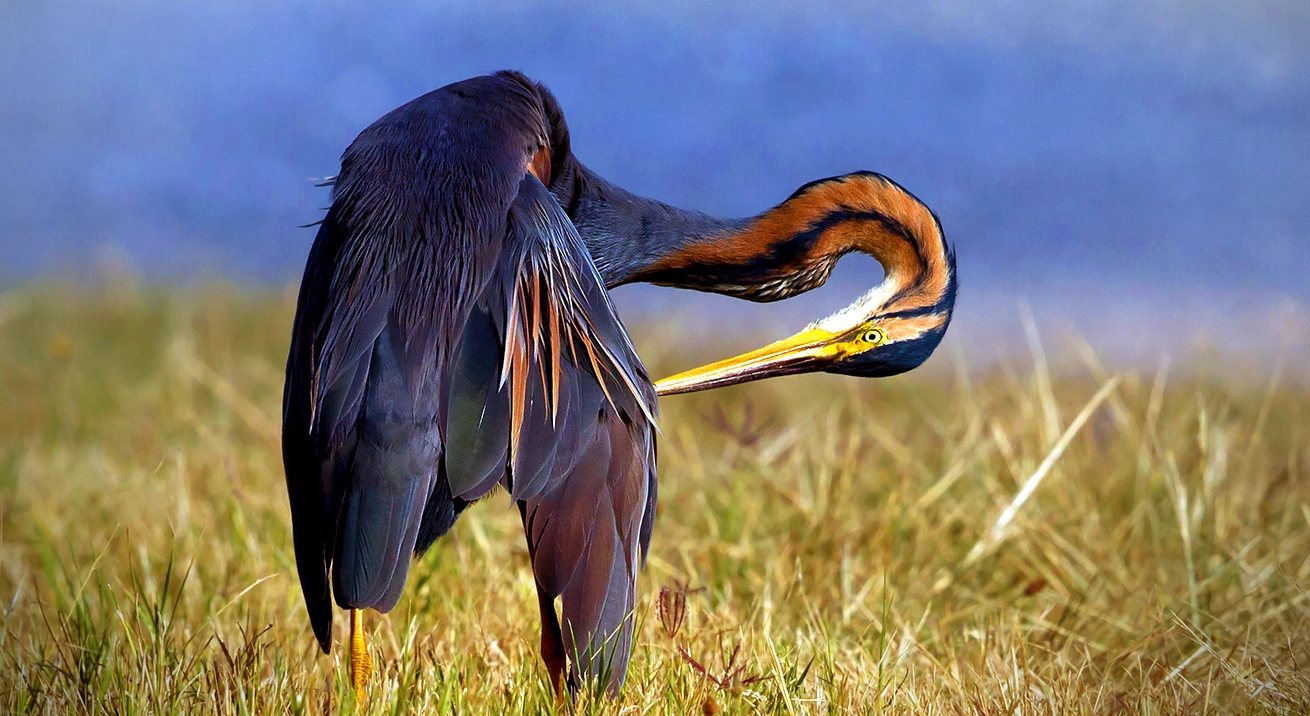
11. PURPLE HERON (Ardea purpurea)
- Between March and July (Adults) or September (Juveniles)
This is a large, slender wading bird. The Purple Heron has a distinctive plumage characterized by a mix of dark reddish-brown, gray, and purple tones on the upperparts, and a striped pattern on the neck. It has a long, sharp bill, a long neck, and long legs, which are yellowish-orange in color. Purple Herons prefer wetland habitats such as marshes, swamps, and shallow lakes with dense vegetation, including reed beds, where they can find ample food and shelter. These majestic birds mainly feed on fish, amphibians, and aquatic invertebrates, but they may also consume small mammals, birds, and insects. They hunt by standing still or walking slowly in shallow water, using their long neck and bill to strike at prey with remarkable speed and accuracy. Their secretive nature and camouflaged plumage make them difficult to observe, but their striking appearance and specialized hunting behavior make them fascinating subjects for birdwatchers and naturalists alike. This is one of the most uncommon birds of Algarve. However, this species can be observed in small numbers in sites like Salgados, Almargem, Vilamoura, Dunas Douradas and Garrão.
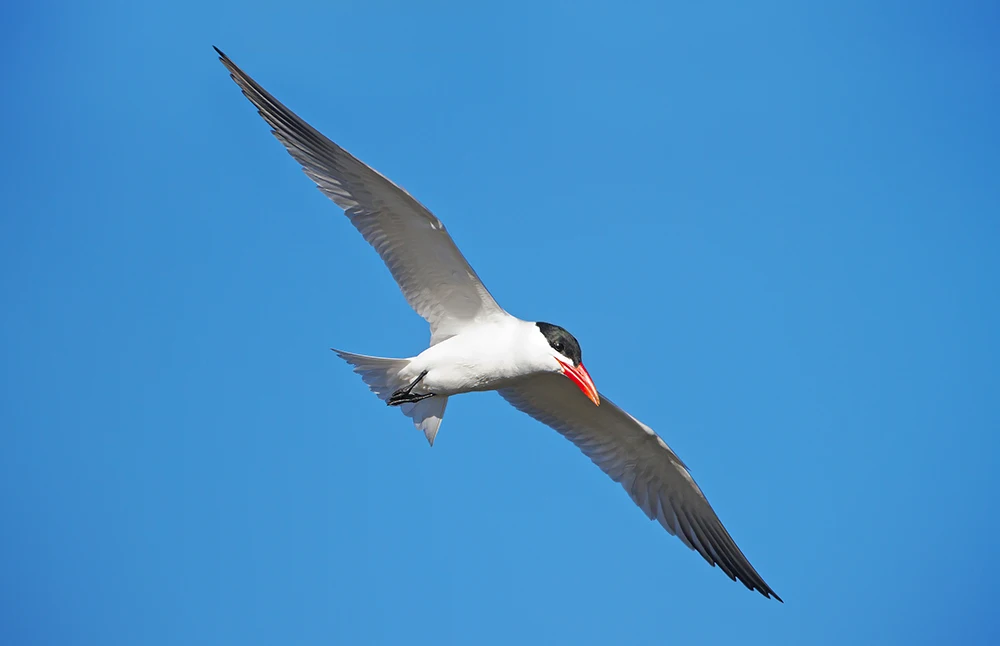
12. CASPIAN TERN (Hydroprogne caspia)
- Between August and March
This is the world’s largest tern. The Caspian Tern has a primarily pale gray and white plumage, with a black cap on its head during the breeding season. Its bill is large, thick, and bright red, while its legs and feet are black. Juveniles have a more mottled appearance with brownish markings on the upperparts. Caspian Terns prefer a variety of aquatic habitats, such as coastal areas, estuaries, lakes, and large rivers, where they can find an abundance of fish. These birds primarily feed on fish, which they catch by performing spectacular plunge-dives from the air into the water. The Algarve is the best region in Portugal to observe this giant tern, namely in Ludo, Salgados, Alvor, Tavira, and Castro Marim.
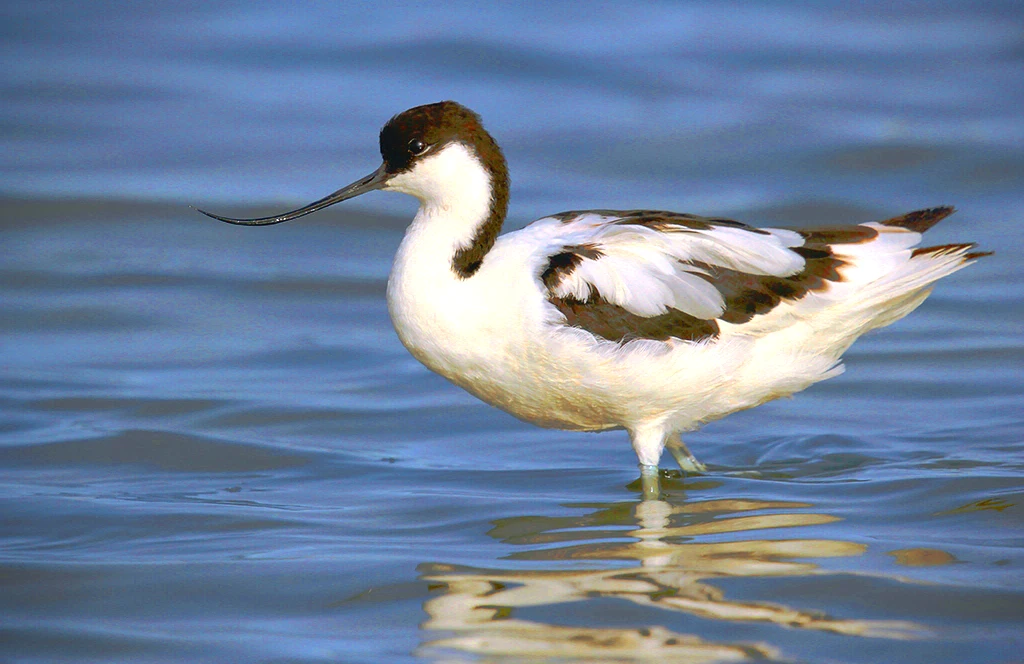
13. PIED AVOCET (Recurvirostra avosetta)
- Between October and March
The Pied Avocet is a striking wading bird with a distinct black and white plumage (white body and black wings, back, and cap). Its most characteristic feature is its long, thin, upturned bill, which is used for sweeping through shallow water to catch prey. The bird’s legs are long and blue-gray in color. Pied Avocets prefer wetland habitats such as coastal lagoons, estuaries, mudflats, and shallow lakes, where they can find an abundance of invertebrates to feed on. These birds primarily feed on small aquatic invertebrates, such as crustaceans, insects, and worms. Their elegant appearance and specialized feeding behavior make them a favorite among naturalists and birdwatchers. Due to their local abundance, Portugal is one of the best countries in Europe to observe this species. Despite being mainly a migratory bird, many Pied Avocets are resident in locations such as Castro Marim and Ria Formosa (including in sites like Ludo, Quinta do Lago, and Tavira).
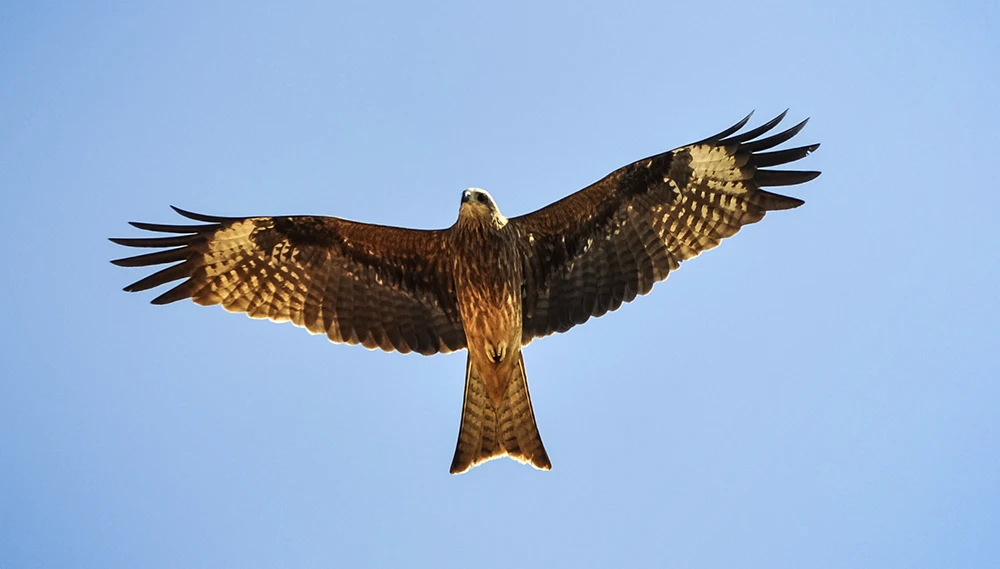
14. BLACK KITE (Milvus migrans)
- Between March and August
A medium-sized bird of prey, the Black Kite has a mostly dark brown plumage (which appears almost black from a distance) with paler streaks on the head and neck. Its tail is long and forked, and its eyes are dark with a distinctive yellowish cere (the soft skin at the base of the beak). Black Kites are highly adaptable and can be found in various habitats such as open grasslands, wetlands, wooded areas, and urban environments. These birds are opportunistic feeders, primarily consuming carrion, but they also hunt for live prey. One of the best places to see Black Kites in the Algarve is Ludo (during the breeding season); the Black Kite can also be seen in the vicinity of Cape St. Vincent during the fall migration.
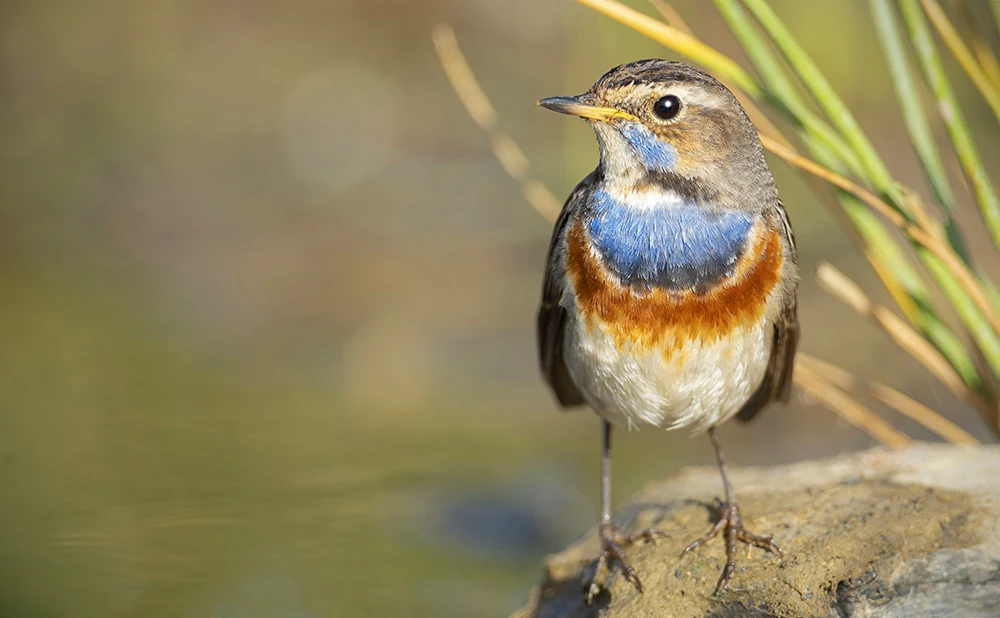
15. BLUETHROAT (Luscinia svecica)
- Between January and March | Between August and December
The Bluethroat is characterized by its colorful throat, which features a bright blue patch with a central, rusty red or white spot, depending on the subspecies. The rest of its plumage is more subdued. Bluethroats prefer wetland habitats such as marshes, damp meadows, and riverbanks, often with dense vegetation cover. These birds primarily feed on insects and other small invertebrates, which they catch on the ground or in low vegetation. They are known for their melodious, varied song, which they use to establish territories and attract mates. Salgados, Alvor and Vilamoura are the best bird hotspots in the Algarve to observe this lovely species.
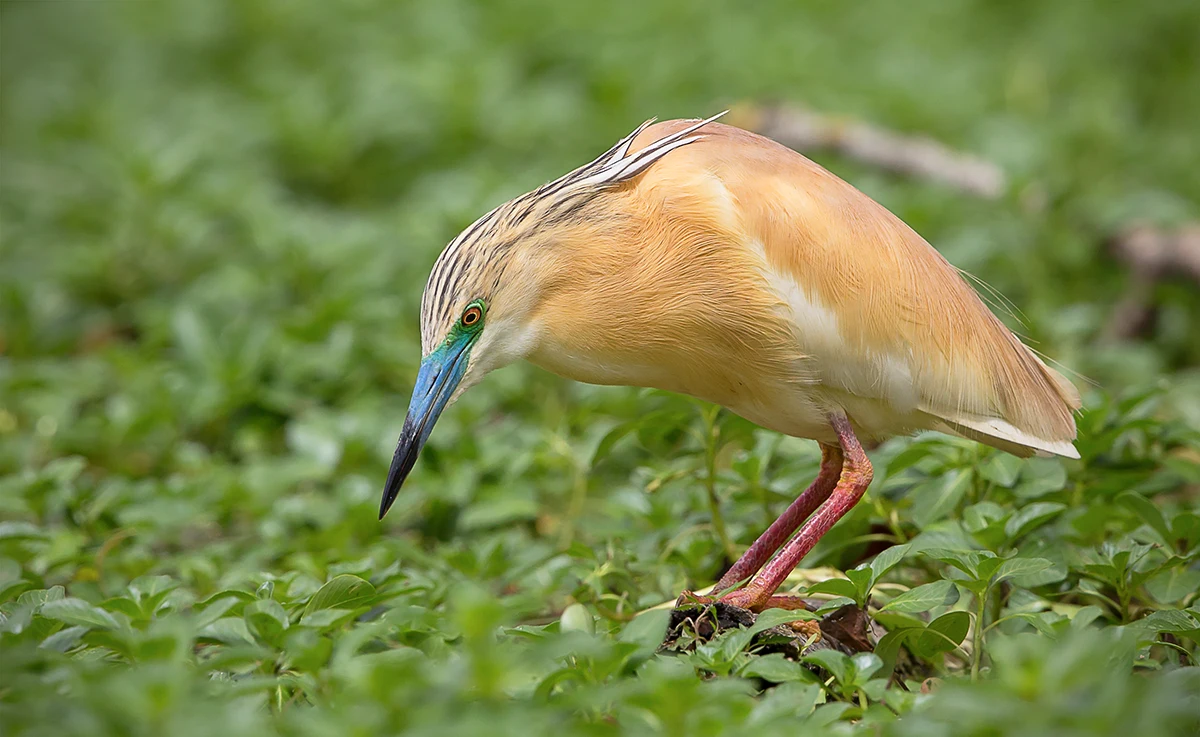
16. SQUACCO HERON (Ardeola ralloides)
- Between August and October
This is a small, stocky, colorful heron. The Squacco Heron has a buff-yellow plumage with a white underbody; during the breeding season, its head is adorned with elongated, golden feathers and the bill becomes bright blue. In flight, this bird looks mostly white due to the colour of the wings. Squacco Herons prefer wetland habitats such as marshes, swamps, shallow lakes, and riverbanks, often with dense vegetation. These birds primarily feed on aquatic invertebrates, such as insects, crustaceans, and mollusks, as well as small fish, and amphibians. Squacco Herons are patient hunters, often standing motionless in shallow water or among vegetation, waiting for prey to come within striking distance. Their remarkable appearance, coupled with their ability to blend into their surroundings, make them a fascinating subject for birdwatchers and nature enthusiasts. It is one of the rarest, most elusive birds of Algarve. However, this species can often be observed in Salgados and Quinta do Lago.
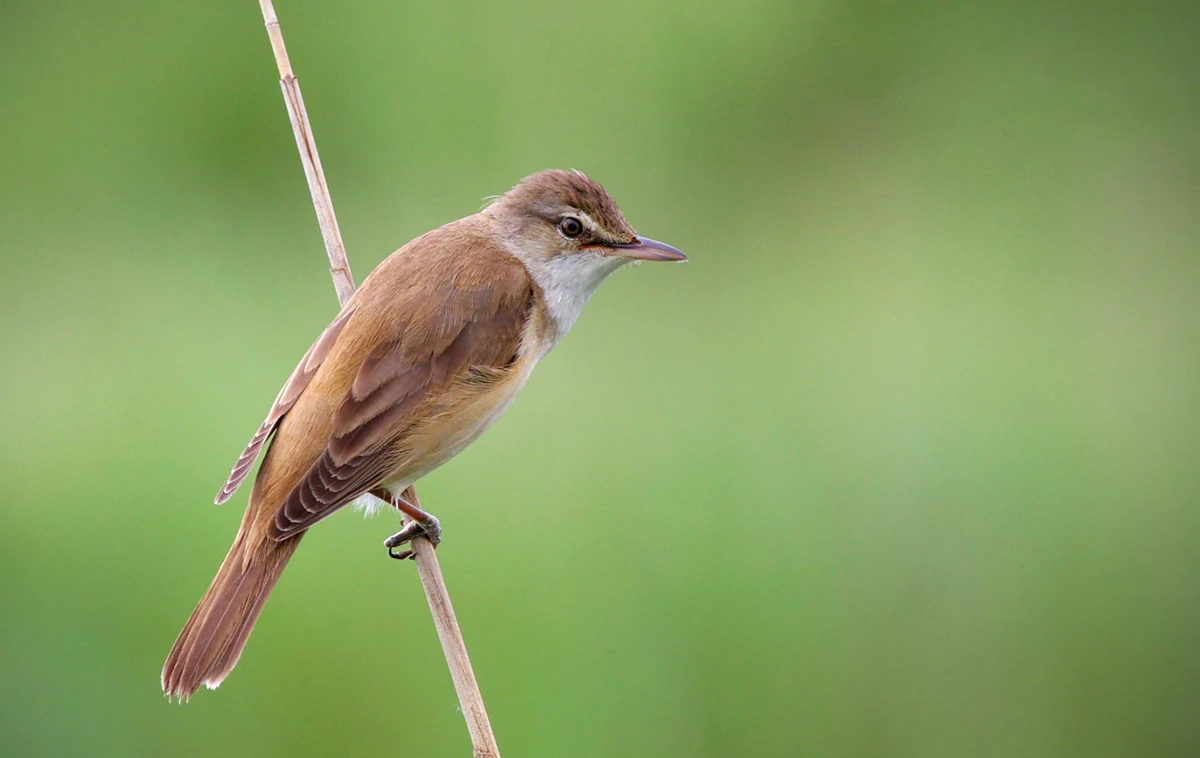
17. GREAT REED WARBLER (Acrocephalus arundinaceus)
- Between March and August
A large warbler, this species has a brownish upper body and a buff-colored underbody. The bird’s plumage is subdued, helping it blend in with its surroundings. Great Reed Warblers prefer wetland habitats with tall, dense vegetation, such as reed beds and marshes. Their well-camouflaged appearance and preference for dense vegetation make them a challenging but rewarding subject for birdwatchers. Unfortunately, their once healthy numbers are decreasing in the Algarve. This species is present in places such as Vilamoura, Almargem and Ludo.
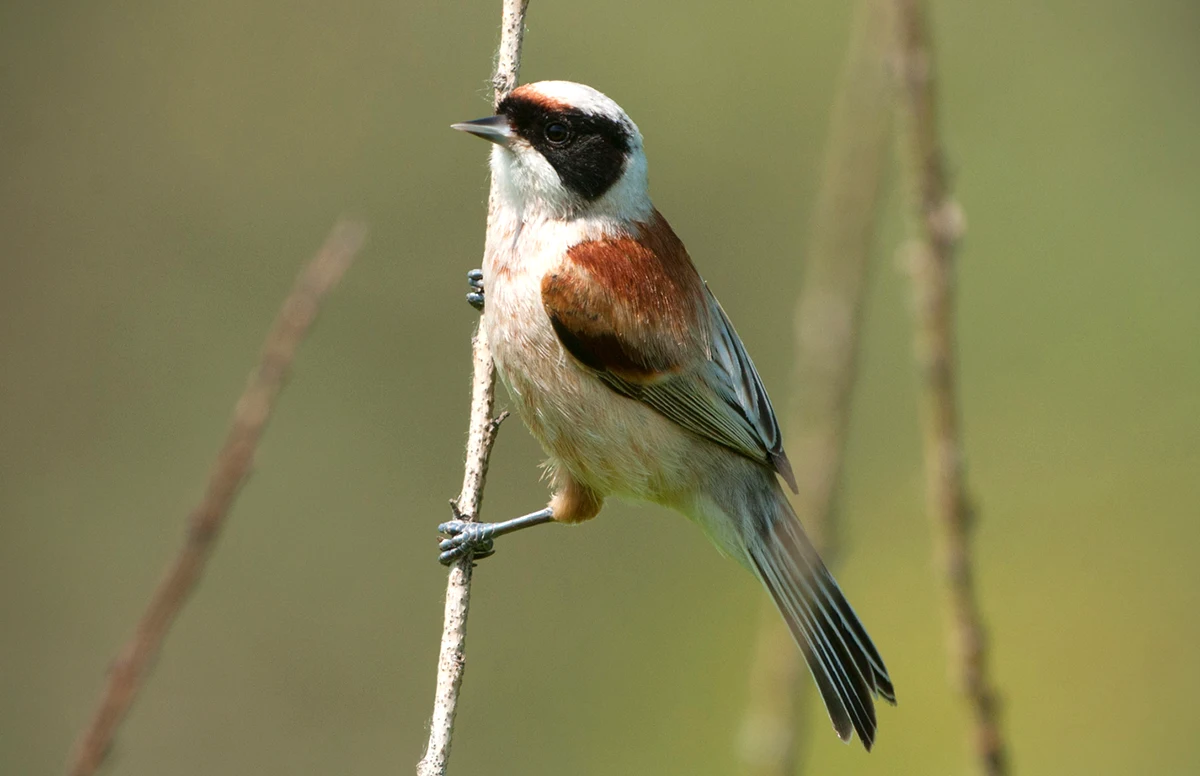
18. EURASIAN PENDULINE TIT (Remiz pendulinus)
- Between October and March
This species of Penduline Tit has a distinctive appearance with a short, pointed black bill, black mask around its eyes, and a pale, creamy-brown body. This bird prefers to inhabit wetlands, riverbanks, and lakesides with abundant vegetation such as reed beds, willows, and shrubs. It is known for its remarkable hanging nests, which it constructs from plant materials like reed fibers, grass, and spider webs. These nests are typically built over water, providing protection from predators. In the Algarve, this species is seasonally present in locations like Paul de Lagos, Vilamoura and Alvor.
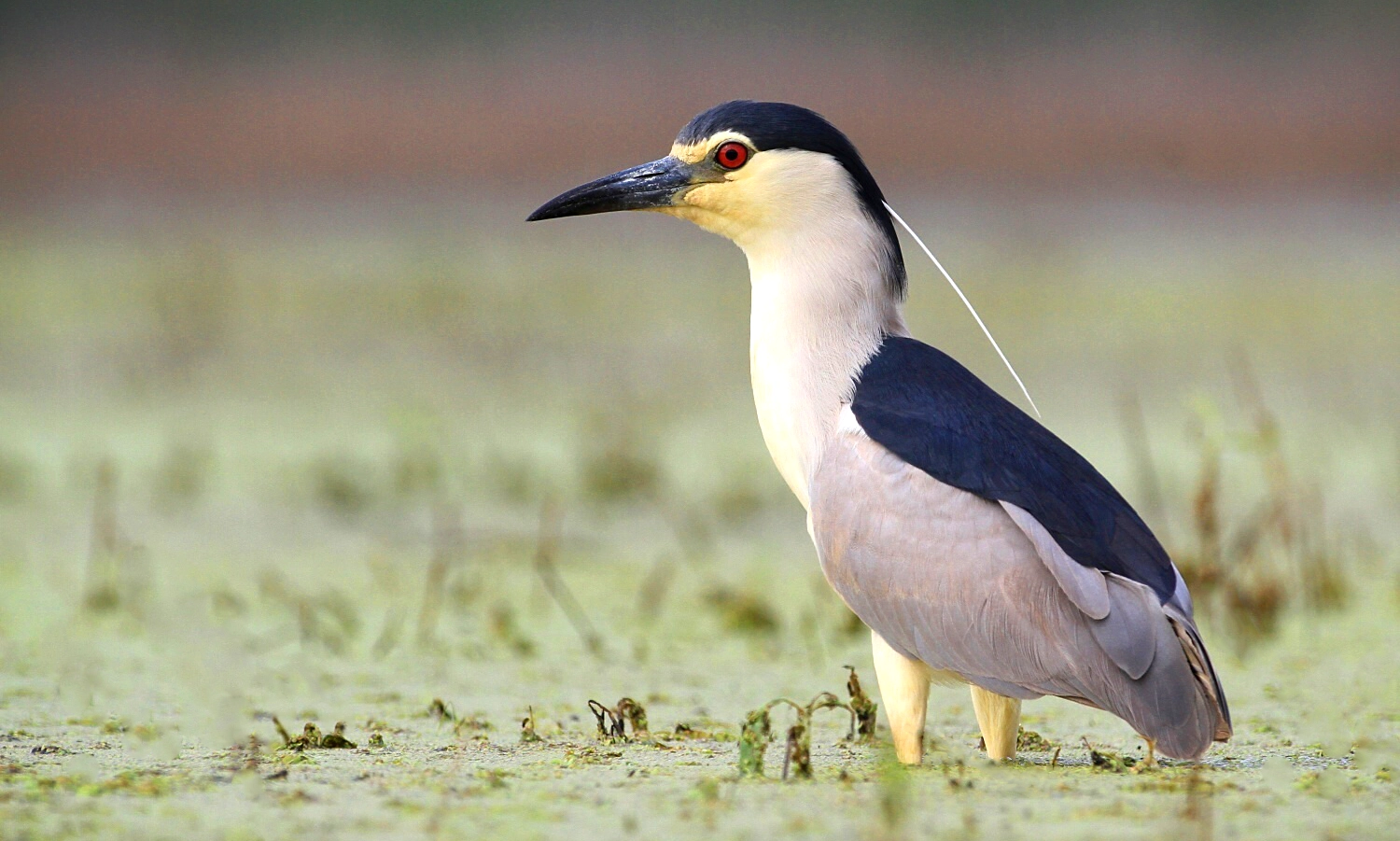
19. BLACK-CROWNED NIGHT HERON (Nycticorax nycticorax)
- Between April and September
A medium-sized heron, this species has a stocky appearance, with a short neck and legs compared to other heron species. Its plumage is mostly grey and white, with a black crown and back, and a distinctive white or pale grey cheek patch. The heron’s eyes are red, and it has a relatively short, stout bill. Primarily nocturnal, Black-crowned Night Herons prefer a variety of wetland habitats such as marshes, swamps, lakes, rivers, and estuaries, often with dense vegetation for cover. Despite being a rather infrequent species in the Algarve, these birds actually occur in Ria Formosa, Dunas Douradas and Ludo.
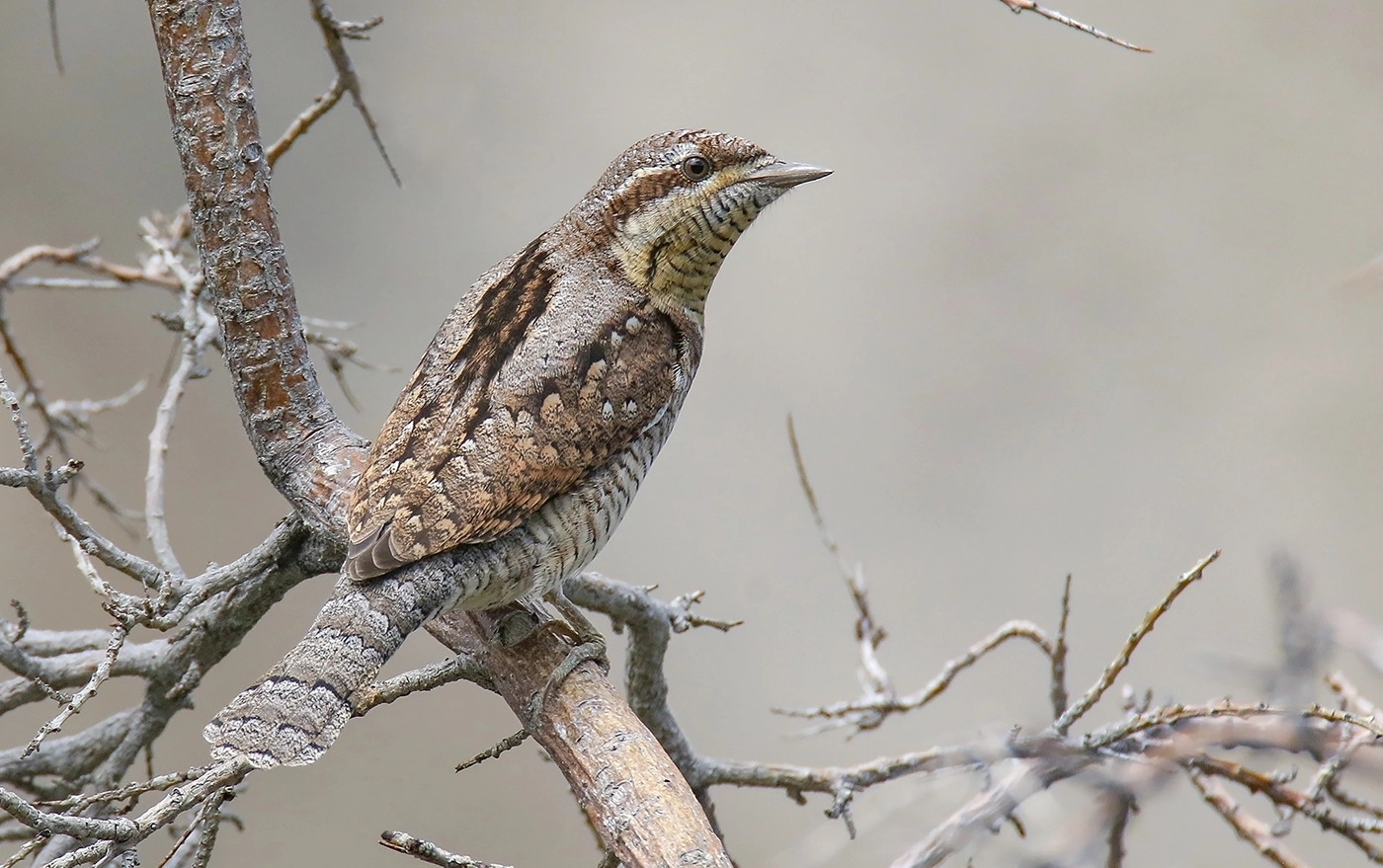
20. EURASIAN WRYNECK (Jynx torquilla)
- Between April and October
This is a cryptically colored bird in the woodpecker family. It has a relatively short bill and a distinctive, barred plumage with shades of brown, grey, and black, which provides excellent camouflage. The bird is named after its unique ability to twist and bend its neck in an almost snake-like fashion when threatened or disturbed. Eurasian Wrynecks prefer to inhabit open woodlands, orchards, farmlands with scattered trees, parks, and gardens. They can also be found in scrublands, hedgerows, and deciduous or mixed forests with significant undergrowth. These birds are insectivorous, primarily feeding on ants and their larvae, but may also consume other insects and spiders. Their distinctive call, a series of short, repeated notes, is often heard during the breeding season. In the Algarve, it nests in the hilly countryside. They also appear in Quinta do Lago and Dunas Douradas. During the autumn migration, the Wryneck can be observed in Alvor and Cape St. Vincent.
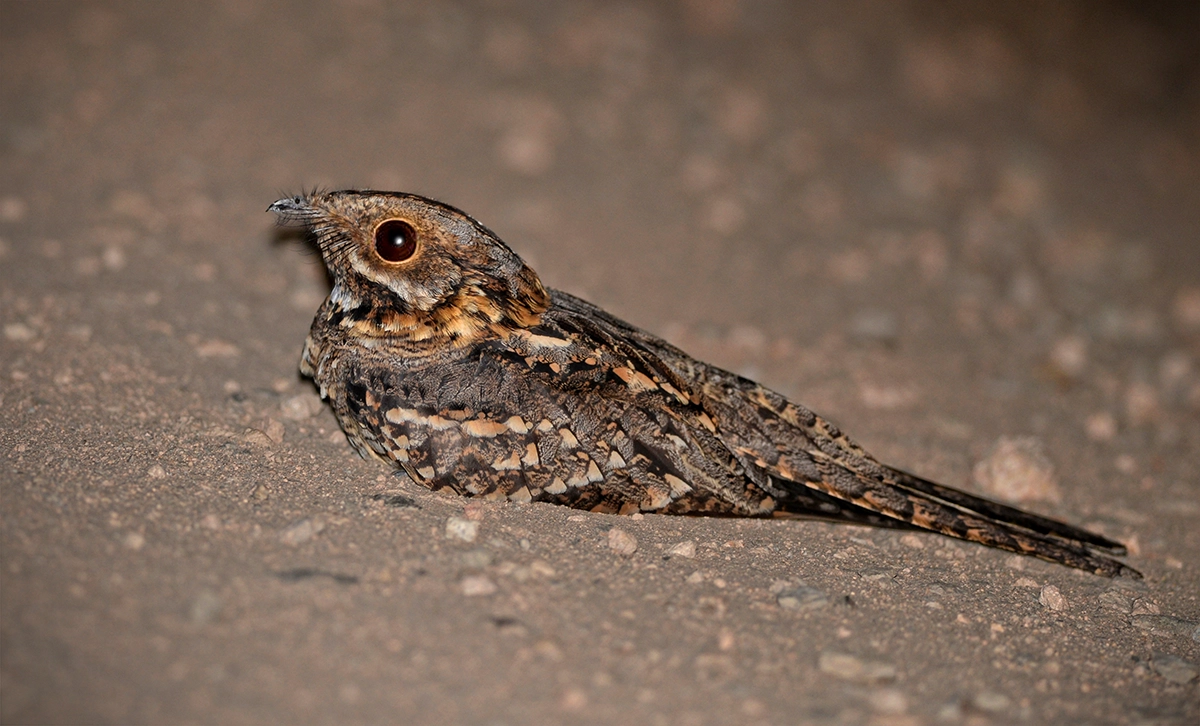
21. RED-NECKED NIGHTJAR (Caprimulgus ruficollis)
- Between April and September
One of the most secretive birds of Algarve, the Red-necked Nightjar is the biggest of the nightjars occurring in Europe. It has a mimetic appearance, featuring cryptic plumage with a mix of brown, gray, and buff tones, which provides excellent camouflage against its natural surroundings. It has a short, broad bill and very large, dark eyes adapted for night vision. This species occupies open habitats such as heathlands, scrublands, woodland clearings, farmlands, and river valleys, usually with sandy or rocky soil. It can be found in regions with a Mediterranean climate across southern Europe, the Iberian Peninsula, and North Africa. The Red-necked Nightjar is most active during the night, feeding primarily on flying insects like moths, beetles, and other invertebrates. This ‘near threatened‘ species occurs throughout the Algarve, namely in Castro Marim, Alvor, Ludo and Quinta do Lago.
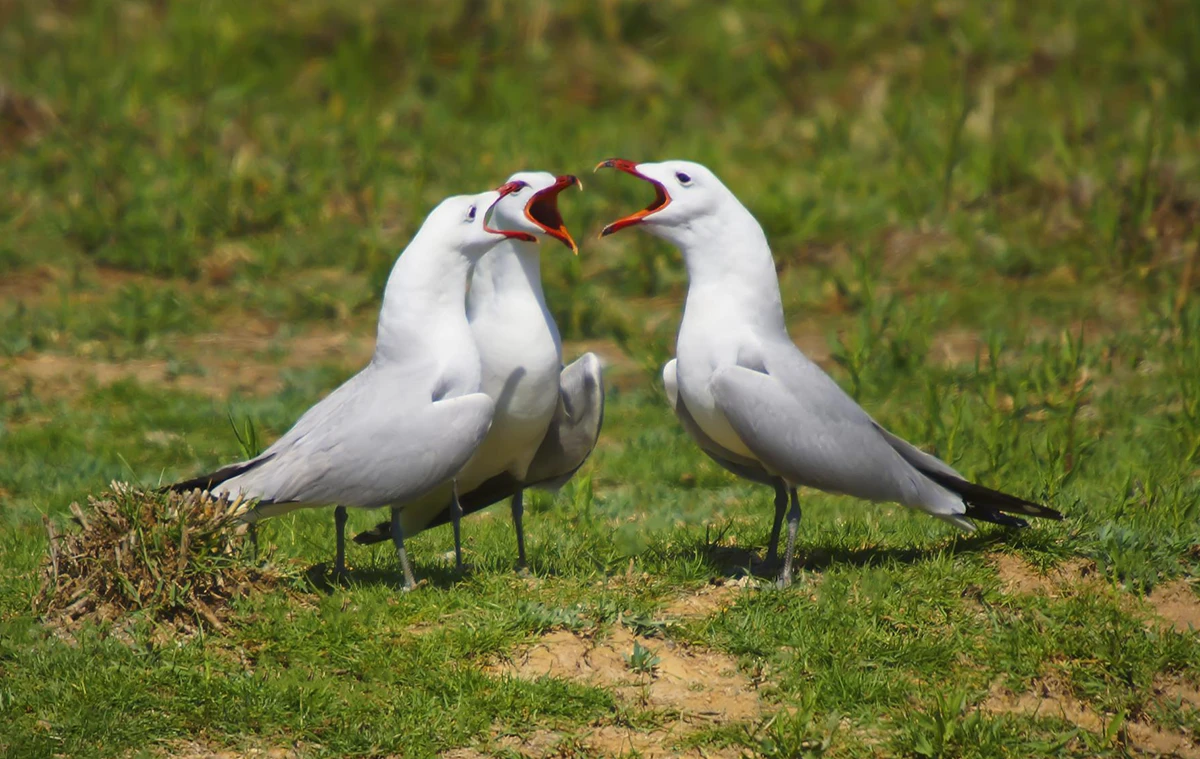
22. AUDOUIN’S GULL (Ichthyaetus audouinii)
- Between May and October
This seabird has a slender, dark red bill with a black tip, and pale gray upperparts. The underparts are white, and the legs and feet are gray. Audouin’s Gull prefers coastal habitats such as rocky or sandy beaches, islands, lagoons, estuaries, and coastal cliffs. Its range is primarily concentrated in the Mediterranean Sea, with populations also found along the Atlantic coast of Spain, Portugal, and Morocco. Contrary to other gulls, this species seldom scavenges. It feeds mainly on fish, which it catches by surface diving, plunge diving, or seizing prey from the water’s surface. It may also consume invertebrates, such as crustaceans and mollusks. In the Algarve, this vulnerable species occurs in Tavira, Castro Marim, Salgados, Alvor, Deserta Island and Cacela Velha.
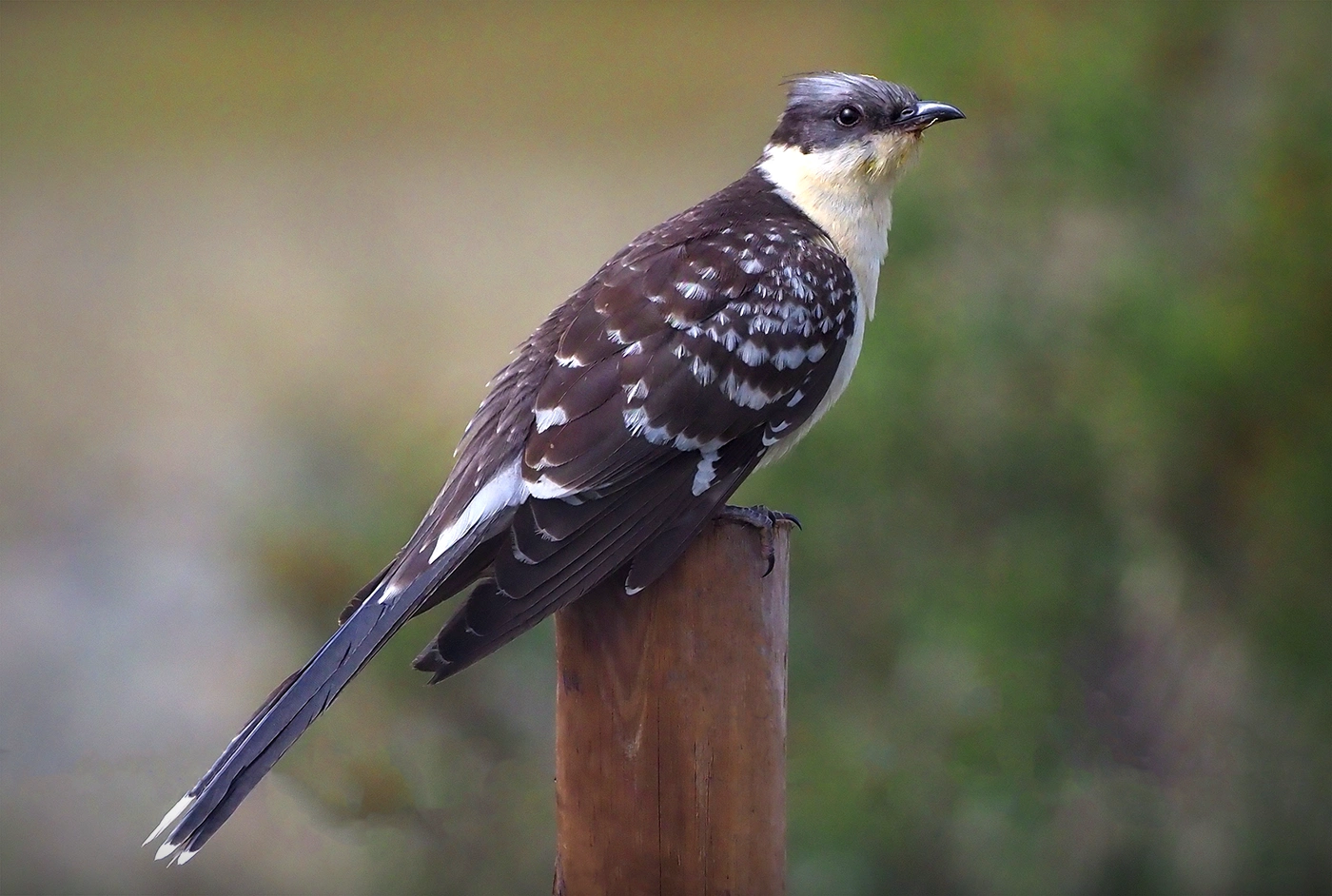
23. GREAT SPOTTED CUCKOO (Clamator glandarius)
- Between January and June
This intriguing species has a distinctive appearance with an elongated, sleek body, a long tail, and a slightly curved, black bill. The plumage is a mix of gray and brown on the upperparts, with large white spots on the wings. The head is capped with a shaggy, gray crest. The Great Spotted Cuckoo prefers a variety of open habitats, including savannas, steppes, woodland edges, agricultural areas, and orchards. The species is primarily insectivorous, feeding on caterpillars, beetles, and other insects. It is known for its fondness for hairy caterpillars, which are avoided by many other birds due to their irritating hairs. The Great Spotted Cuckoo is also a brood parasite, meaning it lays its eggs in the nests of other bird species. Castro Marim is the best place to observe this bird in the Algarve. However, it is much more abundant in nearby Alentejo.
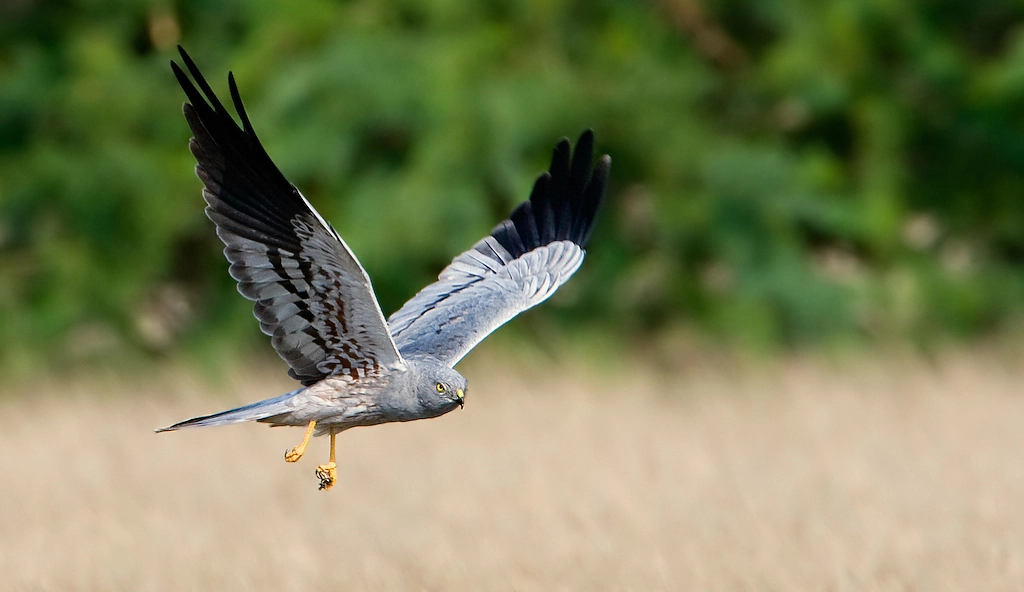
24. MONTAGU’S HARRIER (Circus pygargus)
- Between March and September
Like the previous bird, the Montagu’s Harrier is much more common in the Alentejo. In the Algarve, it occurs in Castro Marim (during the breeding season) as well as in Cape St. Vincent during migration. The species exhibits sexual dimorphism, with the male and female displaying distinct differences in appearance. When not melanistic, males have a slim body, long wings, and a long tail. Their plumage is predominantly gray, with black wingtips and a white underside. Females have brown plumage. The Montagu’s harrier prefers open habitats such as grasslands, heathlands, wetlands, marshes, and agricultural fields. The species feeds primarily on small mammals, birds, and insects, which it hunts by soaring low over the ground and using its keen eyesight to spot prey.
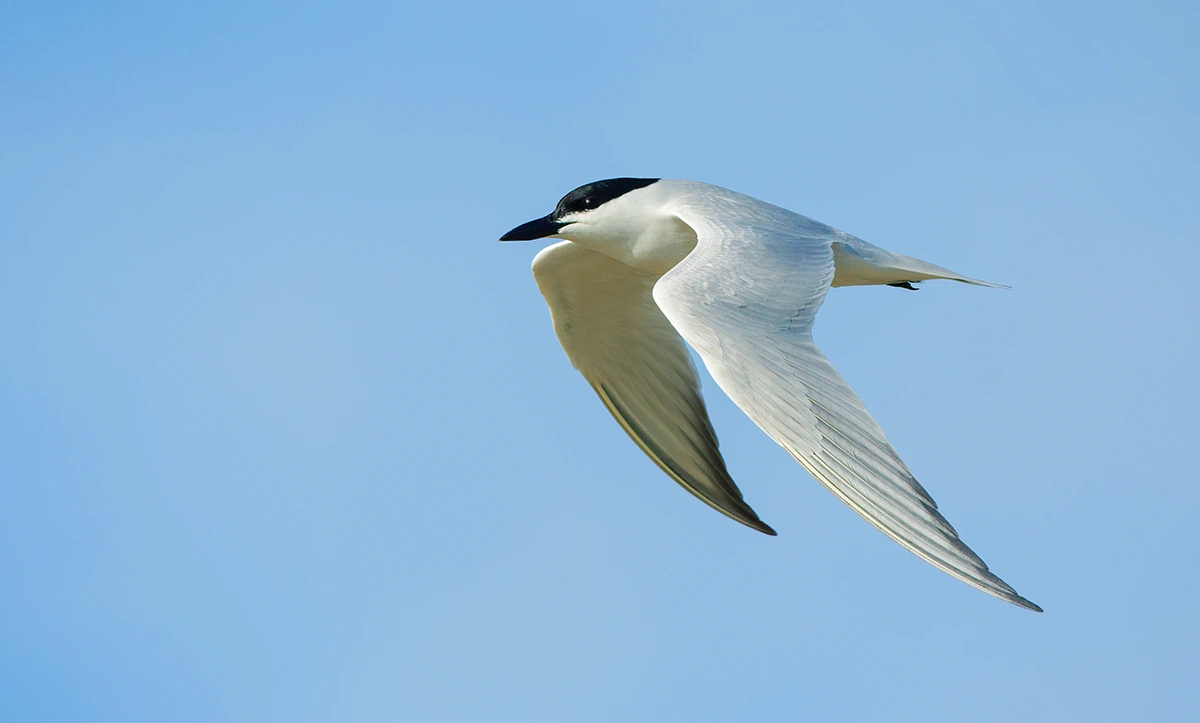
25. GULL-BILLED TERN (Gelochelidon nilotica)
- Between May and September
This strong tern has a stout, black bill, which resembles that of a gull. The bird’s plumage is mainly gray on the upperparts and white on the underparts, with a black cap during the breeding season that turns into a patchy black crown in the non-breeding season. Its legs and feet are black. This species prefers a variety of coastal and inland habitats, such as estuaries, lagoons, marshes, riverbanks, and lakeshores, as well as open agricultural areas and grasslands. It feeds on a diverse diet, including insects, small mammals, birds, amphibians, crustaceans, and fish. Unlike other terns, the Gull-Billed Tern typically catches its prey by swooping down from the air or picking it off the ground, rather than plunge-diving into the water. It occurs in Castro Marim and at the Salgados lagoon. It can also be observed in Alvor, but not as frequently.
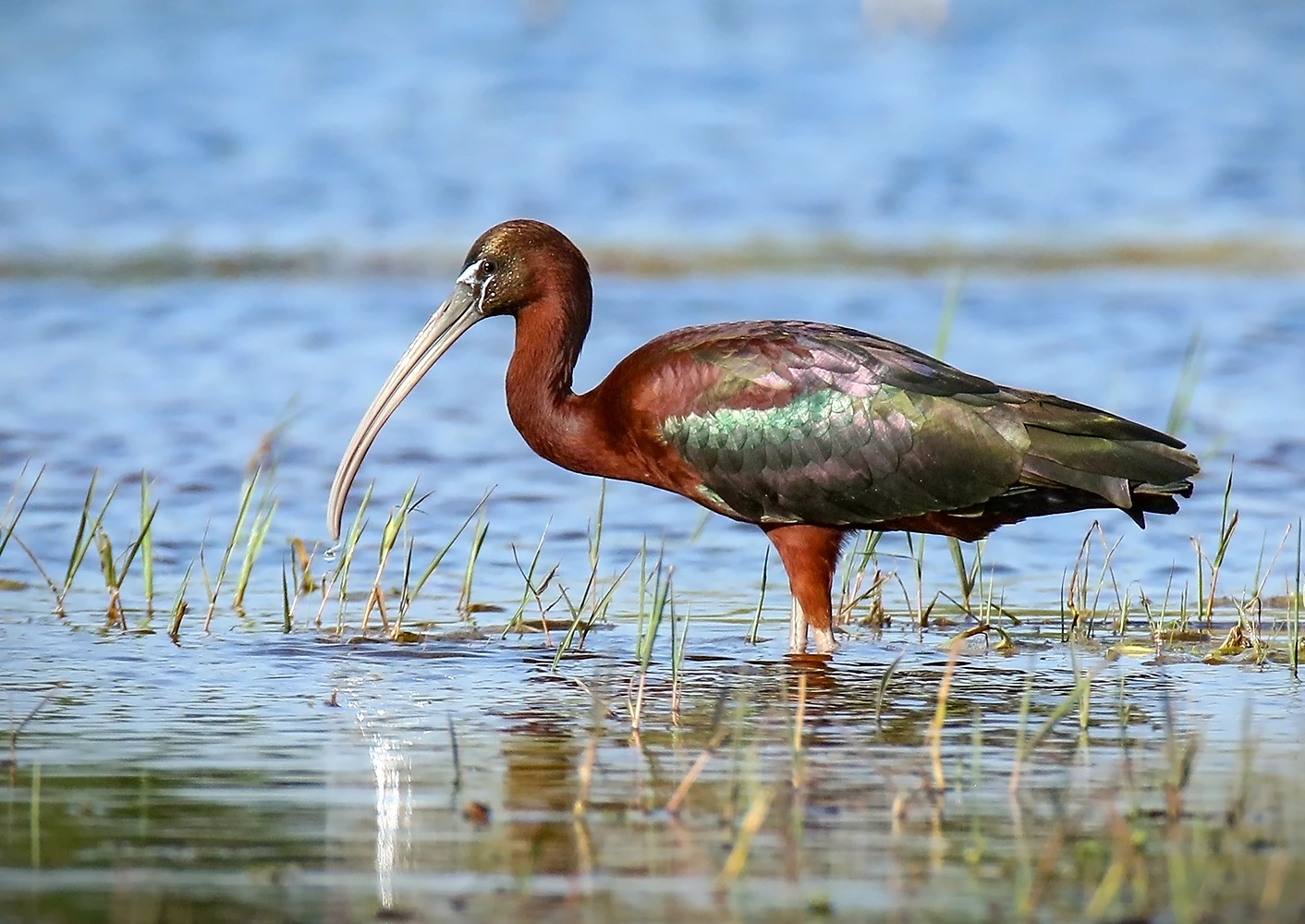
26. Glossy Ibis (Plegadis falcinellus)
- Mainly Between September and March
Like other ibises, the Glossy Ibis has a long, decurved bill and long legs. The bird’s plumage appears dark at first glance, but when observed in good light, it displays a beautiful glossy sheen with iridescent shades of dark bronze, green, and purple. The species prefers wetland habitats, such as marshes, swamps, estuaries, and flooded fields. It feeds primarily on aquatic invertebrates, such as insects, crustaceans, and mollusks, as well as small fish, amphibians, and occasionally plant material. The Glossy Ibis is a migratory bird, with populations from temperate regions moving to warmer areas during the winter months. Migration patterns can be complex, with some populations making long-distance migrations, while others are more sedentary or disperse locally. Those birds can be seen throughout the year in some places in Portugal but they are more frequent during winter. In the Algarve, this species can be seen in Dunas Douradas, Vilamoura, Quinta do Lago, Salgados and Ludo.
Among the birds of Algarve, these were just a few examples. To discover more please explore the Algarve’s main bird hotspots, and get to know a sample of some of the most notable resident bird species of this region.
